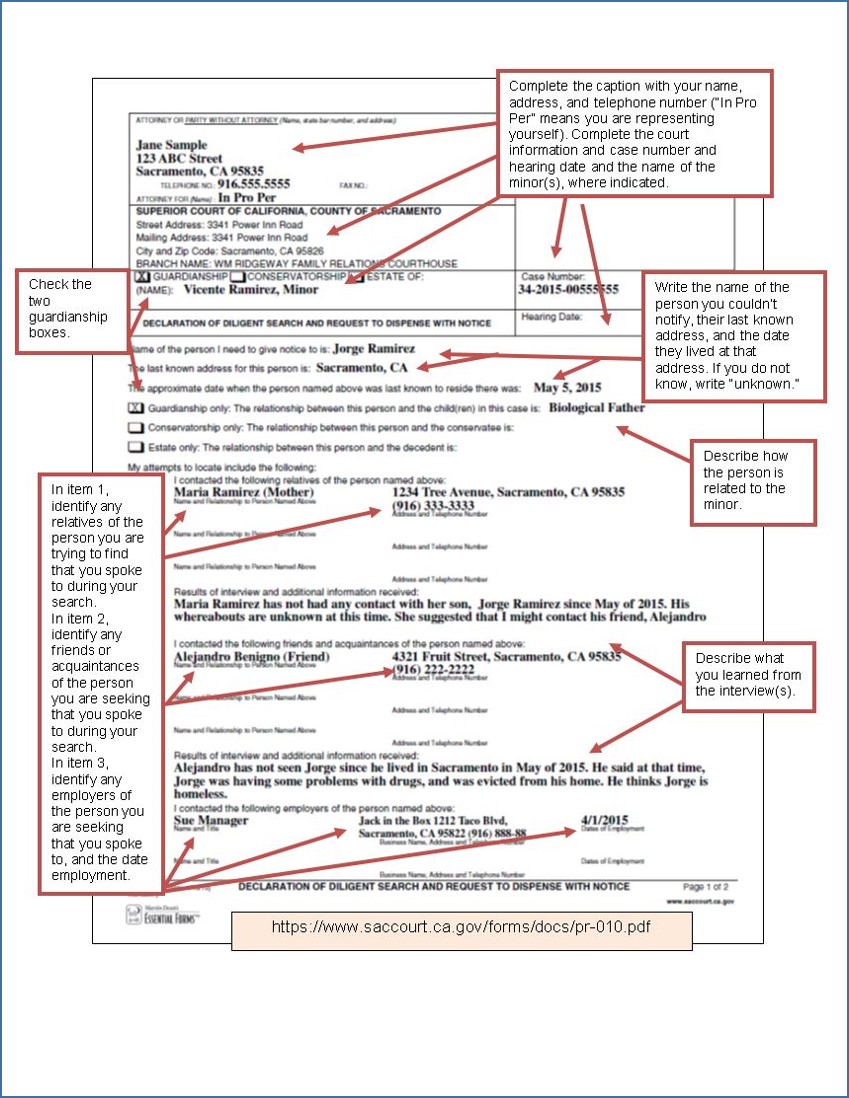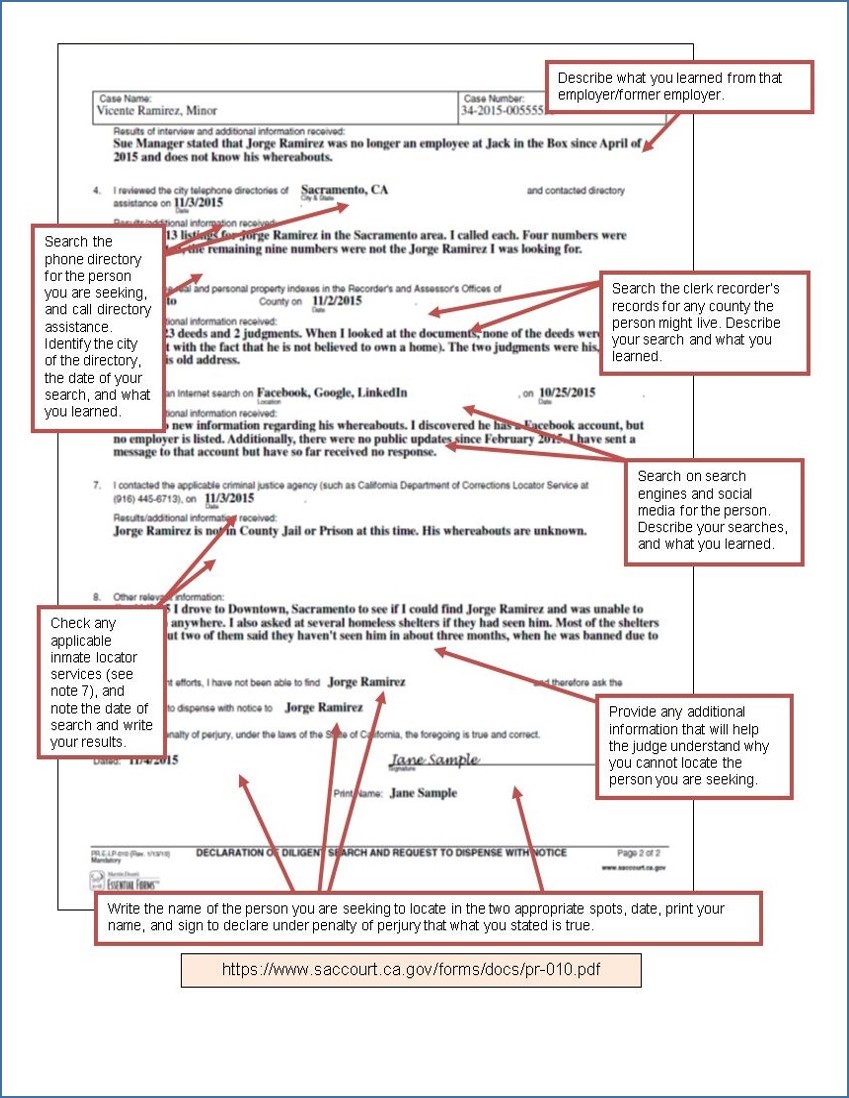Declaration of Diligent Search: Guardianship-Dispensing with Notice to Missing Relative

If you do not know the name or address of a person you need to serve or cannot locate the person, Sacramento County Superior Court requires that you complete and file a Declaration of Diligent Search (PR/E-LP-010) for each person you cannot locate.
You must complete each section of the form, describing the efforts you made to identify and/or locate the person. Failure to complete the entire form can result in your guardianship hearing being continued or even dropped by the court.
Templates and Forms
- Declaration of Diligent Search and Request to Dispense With Notice (Local
Form PR/E‑LP‑010) - Attachment to Judicial Council Form (MC-025)
Step by Step Instructions
1
Complete the Required Forms
Sample filled-in forms with instructions are available at the end of this Guide.
2
Copying and Assembling
Make two copies of your Declaration of Diligent Search and any attachments. In the Sacramento County Superior Court, because documents are scanned into a computer, the original document is left unstapled, while each copy is stapled.
3
File Your Documents
Your Declaration of Diligent Search form must be filed at Probate Front Counter in Room 214 at the William R. Ridgeway Family Relations Courthouse. The Court will keep the original and one copy and return one stamped “Endorsed/Filed” to you. Bring the endorsed copy to all of your Court hearings. There is no fee for filing your Declaration of Diligent Search form. Your request should be filed at least five days before your hearing to allow the court time to review your request prior to your hearing.
If the court is satisfied that you have taken all the reasonably necessary steps to locate the missing relative, the court may issue an order at the hearing to excuse notice to that relative.
For help
SH@LL (Self-Help at the Law Library) (formerly Civil Self Help Center)
609 9th Street, Sacramento CA 95814
(916) 476-2731 (Appointment Request Line)
Services Provided: SH@LL provides general information and basic assistance to self-represented litigants on a variety of civil legal issues, including name changes. All assistance is provided by telephone. Visit “What we can help with” for a list of qualifying cases.
Eligibility: Must be a Sacramento County resident or have a qualifying case in the Sacramento County Superior Court.
For more Information
At the Law Library:
The Guardianship Book for California: KFC 134 .B76
Instructions/General Tips:
Use a different copy of the form for each relative
The form can only be used to describe the efforts to locate one person. If you have more than one person you cannot locate, you will need to complete a Declaration of Diligent Search and Request to Dispense with Notice for each.
Use complete sentences when reporting results
The purpose of this form is to convince the court that you have done everything reasonably possible to locate a person, and describes the minimum of steps that you should go through to try to locate a person. Explaining this effectively typically takes several sentences. If you require more space, you may attach an additional page as an attachment to any paragraph.
Do not use “N/A”
N/A means “not applicable.” When completing the declaration of diligent search, all of the sections are applicable. Instead, use the words “unknown” or “none,” and a full sentence explaining your response to show that you have followed the step and did not skip the section.
Seeking an unknown relative
It is possible that you do not know the name of a relative, but that such a relative almost certainly exists, such as a biological father who does not appear on the birth certificate, and whose identity was never disclosed. Where their name is requested on the form, simply write “unknown” followed by their relationship, for example “Unknown father.”
Paragraph Specific Tips:
Relatives
Contact any relative of the person that you are attempting to locate, to see if that person has information about where to find the person you are attempting to find. Be sure to write down details such as the name and contact information for the person you speak to, and take notes as to what is said.
Friends and Acquaintances
It is often difficult to locate any friends or acquaintances unless you are already familiar with the person you are seeking. When speaking to relatives, be sure to ask if the relative knows of any friends the person you are seeking might have. In addition to identifying the relative by name, address, and phone number, describe clearly what you have learned. If it was impossible to locate any friends or acquaintances, list the steps you took attempting to locate them.
Employers/Former Employers
Identify any employers you contacted for the person, by name, address, phone number, and date of contact. Employers are frequently unknown. If you do not know of any employer or former employer, be sure to ask any family, friends, or acquaintances if they have any idea where the person you are seeking works, or has worked in the recent past. If you cannot identify any employers or former employers indicate “None,” and describe the steps you took attempting to locate an employer.
Telephone Directory and Directory Service
Occasionally the relative you are seeking has a published telephone number and/or address. Check the telephone directory (White Pages) for any city you believe the relative might live. Also, call directory information to see if the information operator has a current address or telephone number. Identify the locations of the directory or directories you have searched, and the date(s) of your search(s). Attempt to contact any listing that might potentially be the relative you are seeking, and describe your results.
Search the County Recorder’s Records
The County Recorder records the transfer of land as well as a number of types of liens, such as abstracts of judgments, for their county. Many counties have their index available online, although they are not able to show you the recorded documents online. Search the index for any county where the person you are seeking might reside. The Sacramento County Clerk Recorder’s document index may be searched online for free. When searching the index, the documents that may help you locate a relative are typically “grant deeds,” “quitclaim deeds” and “judgments,” as these documents are likely to have a last known address. Deeds of Trust are recorded to identify the person authorized to foreclose in the event of a default in a mortgage, and utility liens are likely to have too many addresses listed to be useful.
Internet Search
Search the Internet for the person you are seeking. Use any free tools at your disposal. The court does not expect you to purchase a subscription service or pay for a search. Use each of the major search engines, including Google and Bing. Search for social media profiles on popular services such as Facebook, Twitter, LinkedIn, and any other site you can think of. Identify the services, and describe your results.
Inmate Search
Most counties have a way to search their jail index online to see if someone is an inmate at their jail, while the California Department of Corrections and Rehabilitation maintains an inmate locator service, which can be accessed easily online. Check any county where the person you are seeking might be, and check to see if he or she is in state prison. Indicate the date of the search, and describe your results. The Sacramento County jail roster is available at Inmate Information: Search for Inmates by Name. State prison information may be searched at California Incarcerated Records and Information Search (CIRIS). If you locate the person you are seeking in jail or prison, they should be easy to have served. Check with the facility for their process.
Other Information:
Describe any other ways that you attempted to locate the person you are seeking, and any other information that you know which may assist the court in determining that the person you are seeking to find cannot be reasonably located.
Don’t forget to date, print your name, and sign the form. By signing, you are declaring under penalty of perjury that your statements on the form are true and correct.
Samples


This material is intended as general information only. Your case may have factors requiring different procedures or forms. The information and instructions are provided for use in the Sacramento County Superior Court. Please keep in mind that each court may have different requirements. If you need further assistance consult a lawyer.




